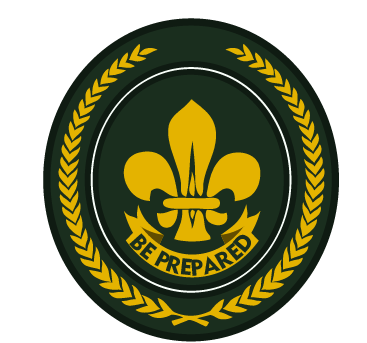First Class Ceremony
First class Ceremony
Baden Powel said “When a [child] has become a First-class Scout — but not before then – [they have] got a grounding in the qualities, mental, moral, and physical, that go to make a good useful [adult].”
The original First-Class Requirements
- Swim 50 yards,
- send and receive a message in Semaphore or Morse

- go on a fourteen-mile expedition over two days, by foot, boat or canoe and write a report on returning,
- know how to deal with a wide range of specified accidents and know the correct first aid techniques to use,
- Cook on an open fire
- know map symbols, draw a sketch map and take a compass bearing,
- use an axe,
- estimate distances, area and capacity to within 25% error,
- and finally train another . . . in the Tenderfoot skills so that [they pass] the test.
Modern Requirements
- Swim 50 yards.
- Throw a lifeline and explain how it fits into the principles and risks of water recreation and water rescue
- Demonstrate correctly the following knots and lashings: Shear lashing, Round lashing, Back splice, Eye splice, Firefighter’s chair, Alpine butterfly
- Estimate, without apparatus, Distance, Height
- Earn the First Aid special proficiency badge.
- Demonstrate your outdoor cooking skills.
- Demonstrate your mapping abilities.
- Read and be able to use a topographical map.
- Draw an intelligible rough sketch map.
- Demonstrate proper use of a compass.
- Point out a compass direction by day and by night without the help of a compass.
- Use a felling axe for felling or trimming light timber
- Complete a First Class Journey.
Originally Swimming was considered the hardest requirement, as the skill and swimming areas were less common. Frequently people complained it should be waived.
BP said: “I look on swimming as a very important step, combining as it does attributes of all three of those classes
- mentally it gives [them] a new sense of self-confidence and pluck;
- morally, it gives [them] the power of helping others in distress and puts a responsibility upon [them] of actually risking [their] life at any moment for others;
- and physically, it is a grand exercise for developing wind and limb.
In our era the Journey our scouts completed demonstrates accomplishment of these goals.
Leader: I now ask the following scouts to come forward – (Kira, Max, Aiden, Anna)
Leader: The First-Class rank represents a significant step in Scouting. It represents the ‘Complete Scout’, having demonstrated all the basic scouting skills.
Leader: As a First Class Scout, you have earned the opportunity to demonstrate the code to which a true and mature Scout is forever bound by his Scout Promise and Law. This code is one of ‘Service’ and ‘Leadership’. Do you accept this greater responsibility of a First Class Scout? If so answer, ‘I do.’
Leader: In qualifying for First Class rank, you have demonstrated skills making it possible for you to live in the outdoors for weeks rather than hours. You have the skills to survive in the wilds, and more importantly the knowledge to prevent the need to survive by planning well and making sound choices.
Leader: The next phase of scouting lies before you. Unless you grow past being a Scout ‘hiker’ and Scout ‘camper’ to being a Scout ‘leader’, you have not experienced the true Scouting life. As you watch other leaders and learn leadership skills, you will understand that a leader is actually a servant. Serving and leading go hand in hand.
As a First-Class scout, you are expected to lead other scouts up the trail with you. Make their path safe, fun, and memorable so one day they can stand here where you are while you have moved on to greater things.
Leader: Wear this badge with pride in your accomplishments. The time it took you to reach this point is not important. The time that lies ahead of you and what you do with that time is all that matters.
(hand out badges)
Leader: Troop, please stand and join me in congratulating these new First Class scouts!


